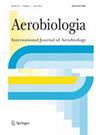Comparison of the characterization of allergenic protein 3 (Pla a3) released from Platanus pollen grains collected in Shanghai during the spring of 2019 and 2020
Abstract
Due to the COVID-19 pandemic in early 2020, large-scale industrial production has been stagnant and reduced, the urban air quality has been greatly improved. It provided an excellent opportunity to explore the effects of air pollutants on the sensitization of pollen allergen proteins in the environment. Platanus pollen grains sampled in the spring of 2019 and 2020 were used for detailed characterization and analysis. Scanning electron microscopy, Fourier transform infrared, X-ray spectroscopy (XPS), trypan blue staining, and western blot analysis were employed to characterize Platanus pollen protein released from pollen grains. Our data showed that the viability of the pollen grains in 2019 was lower compared that in 2020, and the pollen grains collected in 2019 had a higher absorption peak of protein functional groups. The XPS spectra assay result demonstrated that the binding energy of the high-resolution components had not variation on the surface of pollen grains, but relative content of nitrogen and peptide chain in the pollen grains sampled in 2019 were higher than in 2020. These results suggested that more protein in the pollen grains was released onto the surface of pollen grains. In addition, western blot assay showed that the expression of Pla a3 protein in pollen grains sampled in 2019 was significantly higher than that in 2020, revealing that air pollutants could enhance the expression of Pla a3 proteins in Platanus pollen.

 求助内容:
求助内容: 应助结果提醒方式:
应助结果提醒方式:


